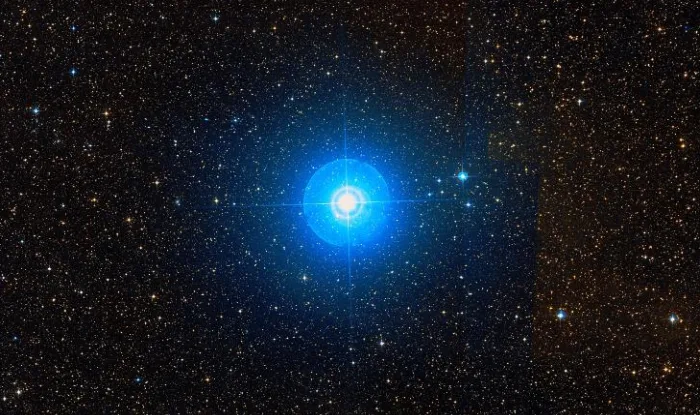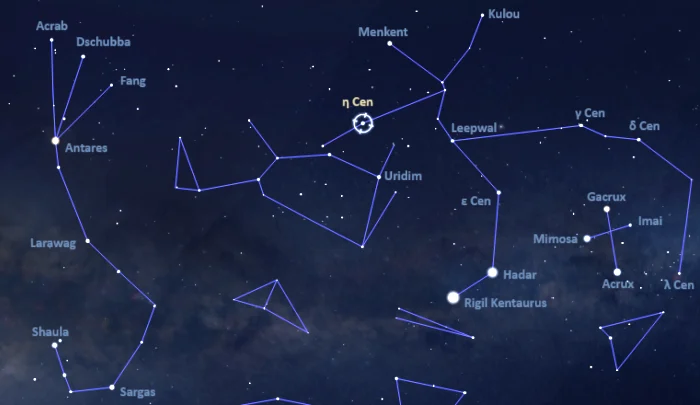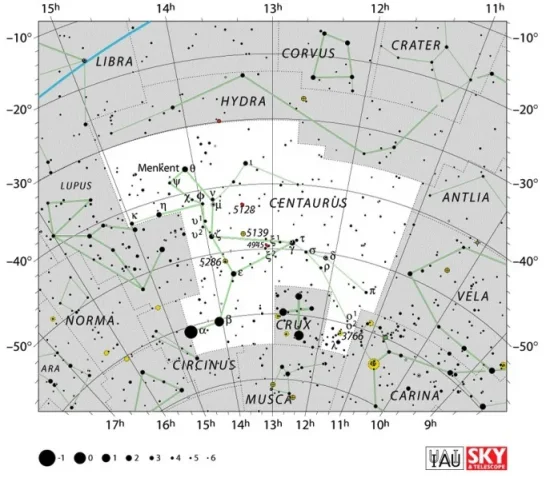Eta Centauri is a hot blue main sequence star located approximately 306 light years away in the southern constellation Centaurus. With an apparent magnitude of 2.35, it is the sixth brightest star in Centaurus. With a mass 12 times that of the Sun, the young variable star is a supernova candidate.
Star type
Eta Centauri is a main sequence star of the spectral type B1.5 Vne or B2 Ve. The “e” suffix indicates that the star has emission lines in its spectrum, while the “n” suffix means that the absorption lines in its spectrum are broadened as a result of fast rotation. Eta Centauri is an exceptionally fast spinner. With a projected rotational velocity of 330 km/s, it takes less than a day to complete a full rotation.
With 12 times the Sun’s mass, the young star is a supernova candidate. Even though it is only around 5.6 million years old, it will evolve away from the main sequence quickly due to its high mass. It has only several million years to go before it suffers a core collapse and goes out as a type II supernova (SNII). In comparison, low- and intermediate-mass stars like the Sun take billions of years to burn through their supply of hydrogen and evolve into red giants.
Eta Centauri has a radius 6.10 times that of the Sun. With an effective temperature of 25,700 kelvin, it is 8,700 times more luminous than the Sun.
Eta Centauri is a Be star, a B-type star with emission lines in its spectrum. These lines indicate circumstellar material expelled from the fast-spinning star. The rapid rotation has contributed to the star ejecting a gaseous disk of material. Eta Centauri is classified as a shell star, surrounded by a detached shell of gas.
Be stars can be classified as Gamma Cassiopeiae variables and Lambda Eridani variables. Eta Centauri is both. Its brightness has been reported to vary from magnitude 2.30 to 2.41. Like Gamma Cassiopeiae in the constellation Cassiopeia, it has a transient, variable equatorial decretion disk that sometimes disappears and reforms, causing the star’s brightness to vary. Like Lambda Eridani in Eridanus, it is a pulsating star. The pulsations contribute to the star’s variability.

Eta Centauri, image credit: ESO/Digitized Sky Survey 2 (CC BY 4.0)
Facts
Shining at magnitude 2.35, Eta Centauri is the sixth brightest point of light in Centaurus, after Alpha Centauri (Rigil Kentaurus and Toliman), Beta Centauri (Hadar), Theta Centauri (Menkent), Gamma Centauri, and Epsilon Centauri.
Eta Centauri is, on average, the 79th brightest star in the sky. It is only slightly fainter than Dschubba (Delta Scorpii) and Larawag (Epsilon Scorpii) in the constellation Scorpius, and Uridim (Alpha Lupi) in Lupus. It narrowly outshines Merak (Beta Ursae Majoris) in Ursa Major, Izar (Epsilon Boötis) in Boötes, and Enif (Epsilon Pegasi), the brightest star in Pegasus.
Eta Centauri is a member of the Upper Centaurus-Lupus subgroup of the larger Scorpius-Centaurus OB association, the closest association of massive, luminous O- and B-type stars to the solar system. The members of Scorpius-Centaurus association are very young stars with an estimated age of 11 – 15 million years. They include many bright stars in the constellations Scorpius, Centaurus, Crux and Lupus, among them the red supergiant Antares, the hot blue subgiant Acrux, the massive blue main sequence star Zeta Ophiuchi, and the blue giants Hadar and Mimosa.
Name
As of 2025, Eta Centauri does not have a formal name officially approved by the International Astronomical Union (IAU). It is one of the brightest stars without a proper name, along with the brighter Gamma Velorum (popularly known as Regor), Gamma Cassiopeiae (Navi), Gamma Centauri (Muhlifain), and Epsilon Centauri.
In traditional Chinese astronomy, Eta Centauri was known as 庫樓二 (the Second Star of Koo Low). It formed the Kù Lóu (Arsenal) asterism with Leepwal (Zeta Centauri), Menkent (Theta Centauri), 2 Centauri, d Centauri, f Centauri, Gamma Centauri, Tau Centauri, D Centauri, and Sigma Centauri. The asterism represented the armory. It was part of the larger Horn mansion, which represented the horns of the Azure Dragon.
Location
Eta Centauri is one of the three bright stars in Centaurus that may be spotted from the mid-northern latitudes at certain times of the year, along with Menkent (Theta Cen) and Kulou (Iota Cen). Eta Centauri appears roughly halfway between Gacrux (Gamma Crucis), the star at the top of the Southern Cross, and Acrab (Beta Scorpii), the northernmost bright star in the Scorpion’s claws.
At declination 42° 09’, Eta Centauri never rises for observers north of the latitude 47° N and stays low above the horizon for observers in the mid-northern latitudes.

The location of Eta Centauri, image: Stellarium
Constellation
Eta Centauri is located in the southern constellation of Centaurus. The celestial Centaur is one of the ancient constellations catalogued by the Greco-Roman astronomer Ptolemy in the 2nd century CE. Occupying 1,060 square degrees of the southern sky, it is the ninth largest constellation in the sky.
Centaurus is also one of the brightest constellations. It is home to Alpha and Beta Centauri, the third and 11th brightest stars in the sky. Alpha Centauri is the nearest star system to Earth. It is composed of the Sun-like stars Rigil Kentaurus and Toliman and the faint red dwarf Proxima Centauri, the closest individual star to Earth.
Other bright stars in Centaurus include the K-type giant Menkent (Theta Centauri), the Beta Cephei variable Epsilon Centauri, the binary star Gamma Centauri, the blue subgiant Zeta Centauri, the Gamma Cassiopeiae variable Delta Centauri, and the A-type dwarf Iota Centauri.

Centaurus constellation map by IAU and Sky&Telescope magazine (Roger Sinnott & Rick Fienberg) (CC BY 3.0)
Centaurus is also home to the hypergiant V766 Centauri, one of the largest stars known, the chemically peculiar Przybylski’s Star, the Mira variable R Centauri, and the Diamond Star (Lucy, BPM 37093), a white dwarf with a diamond core.
Centaurus contains many bright deep sky objects. These include the active galaxy Centaurus A (NGC 5128), the large globular cluster Omega Centauri (NGC 5139), the Blue Planetary Nebula (NGC 3918) and the Running Chicken Nebula (IC 2944). Other deep sky objects in the constellation include the barred spiral galaxy NGC 4945, the Backward Galaxy (NGC 4622), the protoplanetary Boomerang Nebula, the open clusters NGC 3766 (the Pearl Cluster) and NGC 5460, and the blue dwarf galaxy NGC 5253.
The best time of the year to observe the stars and deep sky objects in Centaurus is during the month of May, when the constellation climbs higher above the horizon in the early evening. The entire constellation is visible from locations south of the latitude 25° S.
The 10 brightest stars in Centaurus are Alpha Centauri (mag. -0.27), Hadar (Beta Cen, mag. 0.61), Menkent (Theta Cen, mag. 2.06), Gamma Centauri (mag. 2.17), Epsilon Centauri (mag. 2.30), Eta Centauri (mag. 2.35), Leepwal (Zeta Cen, mag. 2.55), Delta Centauri (mag. 2.57), Kulou (Iota Cen, mag. 2.73), and Lambda Centauri (mag. 3.13).
Eta Centauri
| Spectral class | B1.5 Vne or B2Ve |
| Variable type | Gamma Cassiopeiae and Lambda Eridani |
| U-B colour index | −0.862 |
| B-V colour index | −0.215 |
| Apparent magnitude | 2.35 (2.30 – 2.41) |
| Absolute magnitude | −2.53 |
| Distance | 306 ± 6 light-years (94 ± 2 parsecs) |
| Parallax | 10.67 ± 0.21 mas |
| Radial velocity | 0.00 ± 1.6 km/s |
| Proper motion | RA: -34.73 ± 0.23 mas/yr |
| Dec.: -32.72 ± 0.18 mas/yr | |
| Mass | 12.0 ± 0.3 M☉ |
| Luminosity | 8,700 L☉ |
| Radius | 6.10 ± 0.12 R☉ |
| Temperature | 25,700 K |
| Age | 5.6 ± 1.0 million years |
| Rotational velocity | 330 km/s |
| Surface gravity | 3.95 ± 0.04 cgs |
| Constellation | Centaurus |
| Right ascension | 14h 35m 30.4241610s |
| Declination | −42° 09′ 28.170782″ |
| Names and designations | Eta Centauri, Eta Cen, η Centauri, η Cen, HD 127972, HD 127973, HR 5440, HIP 71352, SAO 225044, FK5 537, CD−41°8917, CPD−41°6839, CPC 0 12445, GC 19656, GCRV 8493, PPM 319680, SKY# 26543, WEB 12321, GSC 07814-03706, GEN# +1.00127972, JP11 2516, N30 3301, AKARI-IRC-V1 J1435304-420928, ALS 15000, EM* MWC 232, EUVE J1435-42.2, TD1 17567, TIC 128116539, ROT 2088, AKARI-FIS-V1 J1435303-420930, uvby98 100127972, UBV 12728, UBV M 20238, AAVSO 1429-41, TYC 7814-3706-1, IRAS 14323-4156, 2MASS J14353043-4209281, Gaia DR2 6103094140452223872 |